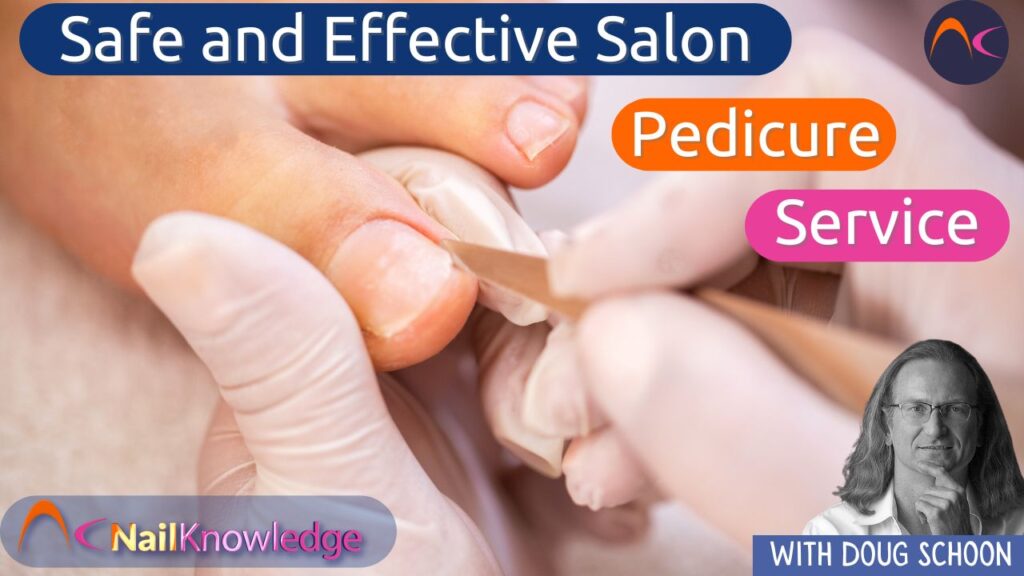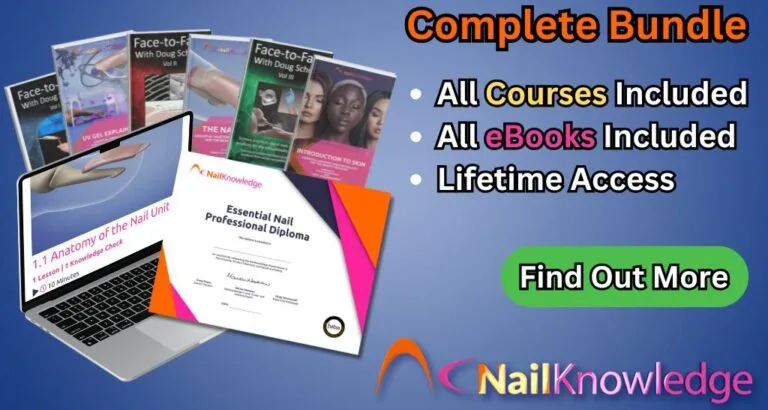Pedicure services are a great value to clients, but many potential clients don’t get salon pedicures. Many are concerned about news media reports concerning injury or infections from salon pedicures. Although this has increased awareness of the potential problems that can result from an improper service, the news media rarely mentions that pedicures, in general, are very safe when properly performed. Instead they present an extreme view, as if clients are taking a great risk. This is done to build drama and make their stories more interesting and scary. However, this is contrary to the facts!
Muitos milhões de pedicures são realizados com segurança nos EUA todos os anos sem incidentes e muitos outros são realizados em todo o mundo. Na grande maioria das vezes, as pedicures de salão são totalmente seguras!
Prevenção de infecções e lesões para proteger a reputação do salão de beleza
However, infections and injuries do occur! When they do, this harms the entire salon industry. I’ve seen these infections and have served as scientific expert in court cases where this has occurred. I want to share what I’ve learned so that nail technicians can avoid these issues, because every time an injury or infection occurs, that’s another black eye for salons everywhere. It’s important for every salon professional to be aware of these issues and understand how to prevent them. This information is needed to maintain a healthy salon environment and provide a safe haven for clientele. Fortunately, this is easy to do, if you know how.
Limpeza e desinfecção essenciais para cadeiras, bacias e bacias de pedicure
Pedicure chair, basin or bowl, they all require proper cleaning/disinfection. This must be done every time, between every client. If you use a disposable basin liner in your pedicure tub, be sure to dispose of them after every use and never reuse them.
Products claiming they are anti-bacterial can’t prevent biofilms or stop bacterial buildup on walls and other surfaces.
Entendendo os biofilmes e a importância da limpeza adequada dos equipamentos de pedicure
What’s a biofilm? When some bacteria congregate in high enough concentrations, they build a protective layer that acts like a nest where they can hide from disinfectants. This layer protects the bacteria, making them much harder to remove or destroy.
An example of a biofilm is the sticky film that builds up inside your mouth overnight or if you don’t brush daily. Using only mouth wash doesn’t get rid of this film, just like rinsing or spraying won’t remove biofilms from pedicure equipment. In fact, they are very difficult to remove without vigorous scrubbing with a clean and disinfected scrub brush. That’s why the best way to deal with biofilms is to avoid letting them form in the first place. Cleaning and disinfecting pedicure equipment between each client prevents biofilm formation, which is why many government regulations related to salons require cleaning and disinfection of pedicure equipment before use on any client.
Why “Anti-Bacterial” Products and Water Sanitizers Aren’t Enough
It is important to note that “anti-bacterial” salon products do NOT replace the need for cleaning and disinfection! Neither do the so-called “water sanitizers”. Water sanitizers only treat the water, not the equipment. They cannot replace cleaning and disinfection. If used alone, these water sanitizers put clients at increased risk of infection. Before use on any client, nail professionals must properly clean/disinfect all pedicure tubs, bowls or basins that come into contact with the previous client’s skin or the water used to perform their pedicure. Of course, the same is true for all disinfectable implements, tools, abrasives, etc.
Prevenção de infecções por meio da proteção da barreira da pele durante a pedicure
Injury and infection can occur from overly aggressive removal of calluses or cutting skin, which can lead to serious infections… even if you sterilize your implements! How can this happen? If the skin on a client’s foot is injured and skin broken- infection will be possible until skin repairs itself! The skin is a barrier and when this barrier is breached, an infection becomes more likely. Clients could pick up an infection at home that evening walking on their own floor if the nail technician:
- Removed too much callus
- Lesões na pele viva com lima e/ou empurrador
- Misused corrosive callus softeners/removers
Cada um desses fatores pode romper a barreira da pele, aumentando a probabilidade de infecções. Tenha muito cuidado ao lixar as unhas para evitar cortes na pele. Uma maneira é marcar novas lixas esfregando as bordas de duas lixas de unha juntas para remover as bordas muito afiadas. Outra maneira é evitar empurrar a pele viva para trás de forma muito agressiva. Isso pode romper os selos que protegem o leito ungueal e a matriz contra infecções.
Calluses protect the feet from friction that can rub skin raw or puncture wounds of the skin. That’s why it is important to only smooth down callus and not completely remove the natural protective barrier the skin has created for itself. The skin creates a callus for a reason, so don’t remove them completely, even if a client insists. Explain to them that you are concerned for their safety.
Uso seguro de produtos corrosivos para calos: Proteja a pele e evite danos
Use callus products with great care, because most are corrosive to skin. That’s how they work. They corrode (dissolve) skin and will do this even to healthy living skin and eyes. I recommend wearing protective gloves and safety eye wear to prevent skin/eye injury.
These products can be seriously damaging to living tissue if they remain on the skin for too long or get into the eyes. They work by softening and slowly dissolving the hardened skin. So, keep these products away from healthy skin. Healthy skin is easier to dissolve than a callus and therefore can be damaged more quickly. If the foot isn’t properly rinsed to remove all corrosive callus products, the residuals left on the foot can slowly damage living tissue. Therefore, be especially careful to remove all products from the foot, as well as from your hand/fingers. Also, be especially careful to rinse well between the toes and along the side walls of the nail plate.
Never use corrosive callus products on the top of the foot. The skin is very thin at the top of foot, so damage can occur quickly. Don’t put corrosive callus products into squirt bottles! These should be carefully applied, to keep them away from healthy skin. They should never be “applied liberally”, instead apply them in a careful and controlled fashion.
Não sele produtos corrosivos para calosidades na pele com filme plástico. Isso acelerará a ação desses corrosivos sobre o calo, razão pela qual alguns fazem isso, mas o filme plástico fará com que eles também corroam mais rapidamente a pele saudável. Evite fazer isso!
I recommend setting a timer so that you don’t forget to remove the corrosive callus product as directed. I’ve seen serious accidents occur when nail professionals were distracted and forgot the client. Leaving these corrosive products on the skin for longer than recommended is very risky and should be avoided, which is why they should be used exactly as directed in the product instructions. Also, make sure to protect your own skin, by wearing protective gloves e.g. nitrile or vinyl.
Evite lâminas de barbear, lâminas e pedras-pomes para cuidar dos calos com segurança
Never use a razor, sharp blades or knives to cut callus. This potentially harmful practice can remove too much callus and can accidentally slice the skin- which will significantly raise the client’s risks of infection. I also do NOT recommend using lava or pumice rocks. These can be over aggressive, especially if callus softeners are used. Besides pumice stones have many cavities on their surface, which trap skin and other debris making them very difficult to properly clean and almost impossible to properly disinfect, so I don’t recommend their use.
Resumo
- Don’t remove calluses: It’s important to avoid fully removing calluses, as they protect the feet from friction and other damage. Excessive callus removal can break the skin barrier, increasing the risk of infection.
- Clean and disinfect everything that comes into contact with the client’s skin or pedicure water: Proper sanitation is essential in preventing infections, as tools and equipment can harbor bacteria if not cleaned and disinfected correctly.
- Use técnicas de limagem cuidadosas para evitar cortes acidentais: A limagem cuidadosa ajuda a evitar cortes acidentais e mantém a pele intacta, reduzindo o risco de infecção.
- When you protect your client’s health, you’re also protecting the reputation of salons everywhere: Garantir a segurança do cliente é essencial para criar e manter a confiança no setor de salões de beleza. Quando os clientes se sentem seguros, isso afeta positivamente a reputação de cada salão e do setor como um todo.


